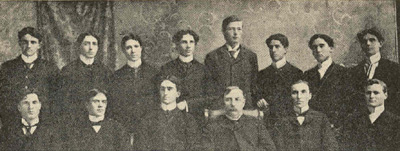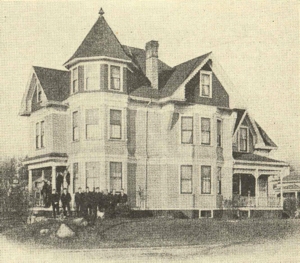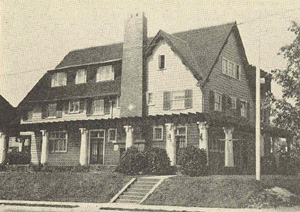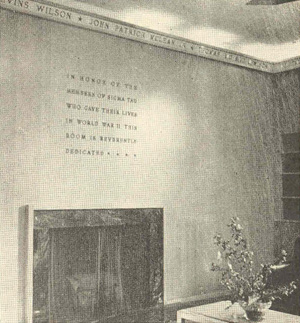By Richard A. Walter (Washington 1939), from records and recollections compiled by Charles A. McKay (Washington 1914) and the late Loyal A. Shoudy (Washington 1904)
Back to History Articles page
The following article about our Sigma Tau Chapter at the University of Washington is dated. Since this article was written in 1951, our Washington chapter has provided three field secretaries and four Archons (including a secretary, treasurer, vice president, and president). The article does not mention the Fraternity awards: nine Cheney Cup wins (five of them between 1985 and 2000), ten Baker Cup wins in thirteen years (1981 to 1994), nine Brightman trophies since 1984, and seven Jordan Bowls. It does talk about excellent graduate support, which has since been recognized. Since the Brightman Award for graduate chapters was first awarded in 1965, the Seattle Graduate Chapter has received it more than twelve times. And the Durrance Award for best Purple Legionnaire has gone to Sigma Tau's advisors three times. Indeed, while this article is not up to date, it proves that Sigma Tau's tradition of excellence is a long one.
If more gold had come out of Alaska's great Klondike Rush of 1897-99, Sigma Tau Chapter at the University of Washington might never have been born. But the same optimistic drive that swept collegians from classroom to gold field later swept them to success in a bid for a Phi Gamma Delta charter, to the position of dominant Greek on a Greek-dominated campus and to the building of one of the strongest fraternity alumni groups in America.
Thirty years or so before the first white families settled in Seattle, Emerson characterized the American man as having a certain rooted withdrawnness and a quiet sensitiveness that grew out of the thoughtful atmosphere of New England's serene countryside. Had he lived to visit the Pacific Northwest, however, Emerson would most likely have retouched this over-simplified picture. For the men who were to carve homesteads from the tall timber of the Pacific Coast ranges, turn burgeoning undergrowth into fertile furrows and sift salmon from the racy tides of Puget Sound were neither rooted nor withdrawn nor quiet nor conspicuously sensitive.
A WAY OF LIFE THAT PERSISTS
They were a friendly lot, disarmingly frank and - to the eyes of sophisticated Easterners - notably naive and over-optimistic. But this spirit caught on and as new folks poured through Cascade mountain passes to join the breathless pursuit of natural wealth and happiness they discovered a way of life that persists in many ways to this very day.
The optimism of the Pacific Northwest is well founded. Not so much on the possible attainment of material wealth, for the section suffers some competitive disadvantages. But many feel that it is fixed firmly on the ever-present blessings of nature, a friendly climate and a vast choice of opportunities for both work and play.
Optimism certainly spurred on the founders of the University of Washington when they set up an outpost of higher learning in the wilderness of Seattle in 1861 - only a decade and a half after it was decided whether the territory would be American or British!
And, with further optimism, they later began to call this frontier institution "The University of a Thousand Years." With today's enrollment of 14,500 students on an evergreen campus of 355 acres, such endurance now seems assured.
Oddly enough, the first seed for a Fiji chapter in the Pacific Northwest was sown at Puget Sound University at Tacoma, which first began instruction in 1890, with an enrollment of 88. P.S.U. closed in 1897, then reopened in 1899, after losing many students to the Klondike and to the University of Washington, whose enrollment then was 514.
ROSS CHESNUT THE ENTREPRENEUR
The chancellor of Puget Sound University from 1892 to its temporary dissolution was a Fiji - Crawford R. Thoburn (Allegheny 1885), who inspired a live-wire student named Ross Chesnut to form a local traternity at the institution in 1894. This society, called Alpha, sought to attract the attention of Phi Gamma Delta.
Brother Chesnut evidently sensed the instability of P. S. U. and extended his organizing abilities to the state university at Seattle, 30 miles north. There he met an energetic faculty member, Charles F. Reeves, who had been initiated as a professor at Pennsylvania State College and who was from 1899 to 1903 dean of the college of liberal arts at the University of Washington.
By the fall of 1895, when the University of Washington moved from downtown Seattle to its present location four miles north, Reeves and Chesnut had formed a sister fraternity named Beta. The local groups - Alpha and Beta - plugged along for two years, even meeting jointly to plan ways to qualify for a Fiji charter. But along came the Gold Rush - firing the imaginations of thousands of able-bodied young men - and both locals were snuffed out. Ross Everett Chesnut left P.S.U. for the gold fields and returned later and no wealthier to enter the University of Washington in September, 1898, as a member of the class of 1899.
"THE ORIGINAL 13" AND PROFESSOR REEVES, THEIR SPONSOR
 Top row: Edgar J. Wright 1901; Glenn W. Caulkins 1901; Tony M. Barloz 1900; Stirling B. Hill 1900; Carl H. Reeves 1901; Fred D. Chesnut 1902; Richard W. Huntoon 1902; William T. Laube 1902. Bottom row: Ernest W. Schoder 1900; Frank P. Giles 1899; Ross E. Chesnut 1899; Professor Charles F. Reeves (Pennsylvania State Faculty), Henry L. Reese 1899; Clarence M. Larson 1899.
Top row: Edgar J. Wright 1901; Glenn W. Caulkins 1901; Tony M. Barloz 1900; Stirling B. Hill 1900; Carl H. Reeves 1901; Fred D. Chesnut 1902; Richard W. Huntoon 1902; William T. Laube 1902. Bottom row: Ernest W. Schoder 1900; Frank P. Giles 1899; Ross E. Chesnut 1899; Professor Charles F. Reeves (Pennsylvania State Faculty), Henry L. Reese 1899; Clarence M. Larson 1899.
Forthwith he worked for a rebirth of Alpha and Beta. Two former members of the latter group had resisted the lure of the Klondike and stayed in the university. They were Frank Price Giles 1899, and Clarence Melrose Larson 1899. With Chesnut, strongly supported by Professor Reeves, they rounded up ten other students and formed a new local, which on February 15, 1899, was christened Gamma Sigma.
CHARTER MEMBERS NUMBERED 13
The 13 members of Gamma Sigma later became the 13 charter members of Sigma Tau of Phi Gamma Delta. In addition to Ross Chesnut, Giles and Larson, they were Henry Lindley Reese 1899.; Tony Marvin Barlow 1900; Stirling Bryant Hill 1900; Ernest William Schoder 1900; Glenn Whitman Caulkins 1901 ; Carl Howell Reeves 1901; Edgar James Wright 1901; Fred Dennis Chesnut 1902; Richard Waldron Huntoon 1902, and William Tell Laube 1902.
This local group had one dominant ambition: to be granted a charter In Phi Gamma Delta, although it. had been approached by other nationals. The "Original 13" felt sure they had a winning combination. They were even superstitious about it, refusing to initiate another man when word came that their petition to the 51st Ekklesia in October, 1899, had been "laid over for the present to allow further consideration," as the convention minutes phrased it.
Undismayed, they appointed a committee to develop a stronger case to bring before the following Ekklesia -- in July of 1900, at Niagara Falls. Although they pledged additional men, they declined to change the roster of petitioners. So the names of the"Original 13" went before the 52nd Ekklesia, which granted the charter unanimously.
The successful petition was supported on the 1900 Ekklesia floor by such fraternity leaders as Archon Wallace W. Everett (California 1897), speaking for what was then Section XIII, comprised only of Delta Xi Chapter; Edward R. Harvey (Nebraska 1901), Chief of section composed of the Kansas, William Jewell, Nebraska and Missouri Chapters; Charles A. Watson (Yale 1875), "who spoke favorably of the men and their financial standing," and, of course, Professor Reeves.
The story, which may or may not be apocryphal, is told that the early opposition by Eastern chapters, on the grounds that the Northwest was too far, too wild and too wooly, was squelched by a dramatic speech by a distinguished Manhattan lawyer.
The new chapter was christened Sigma Tau - Sigma for Seattle and the old Beta and Tau for Tacoma and the Alphas. The installation took place in the old Pacific Block on September 29, 1900. Professor Reeves was the Legate.
Of the "Original 13," nine survive. Giles, Larson and the Chesnut brothers have passed ad astra. Lawyers Laube and Huntoon, Reese the physician and Hill the engineer live in retirement in Seattle. (Brother Laube has always had 13 as his automobile license plate number.) Barlow practices dentistry in Bellingham. Schoder is a retired Cornell professor of mines, living in Ithaca, New York. Wright, Sigma Tau's first President, became a lawyer and is now chairman of the zoning commission in Seattle. Caulkins became a widely known educator and lives in Los Angeles. Reeves, son of Professor Reeves, an engineer, resides in North Hollywood, California.
J.Y.C. KELLOGG ADMITTED TO BOND
A week after the formal establishment of the chapter, the charter members lived up to their promise by initiating their long-standing pledges: Thomas Warner Lough 1900; Walter Henry Tiedeman 1901 ; Kenneth McPherson 1902; Henry Granger Knight 1902; Climie Eugene Hill 1900, and James Young Corey Kellogg 1903.
Doughty Brother Kellogg was first in line after the charter members. He has lived up to this honor and through the years has given generously of his interest to the fraternity. It was he who received the penny postal-card from thrifty Professor Reeves, at Niagara Falls (3,000 miles away) announcing that the charter had been granted.
The 13 rugged individuals who made up the original Sigma Tau were giants on the University of Washington campus. Numbered in their ranks were eight varsity football players, including three captains; five track team stars, four championship debaters, journalists, student assembly and class presidents, actors and glee club singers. One wonders what jobs were left for the other 389 male students in the university!
The Fijis soon set their "pans" for the finest nuggets in the college stream. On October 10, 1900, they initiated -- in addition to the members of Gamma Sigma who were not present at the formal installation -- William R. Hill 1906; L. Ross Carpenter 1904; William W. Reinhart 1901; and Karl VanKuran 1904. Eight days later three more links were added to the golden chain: Benjamin L. Burroughs 1904; WillIam T. Burwell, Jr. 1904; and Loyal A. Shoudy 1904. In April of 1901, they admitted to the penetralia Burton C. Haines 1904, and Sidney J. Williams, 1901, giving Sigma Tau a first-year strength of 23 members.
Sigma Nu was the first fraternity to be established at the University of Washington - in 1896. Numbering 17 members, they were renting a house when faced by their first national competition in
the fall of 1900. Phi Delta Theta had entered the university about the same time as had Phi Gamma Delta and -- as a strong point of persuasion in rushing -- owned a home.
 THE FIRST HOME OF SIGMA TAU
THE FIRST HOME OF SIGMA TAU
The first home of Sigma Tau Chapter was acquired in 1901 and was valued at $5,000. It stood at 4506 Brooklyn Ave. This house was occupied for nine years.
The burning question of a chapter-house for the Fijis began to flare up at every meeting. A suitable residence, valued at $5,000, was found at 4506 Brooklyn Ave. Patron-Professor Reeves came to the rescue. With his loan of $500, the chapter obtained two mortgage loans - and the house. Besides Professor Reeves, Brothers Wright, Shoudy and Kellogg worked long and purposefully to make it possible for out-of-town members to move into the house in 1901.
During the next seven years, the chapter almost doubled in size. The house on Brooklyn began to split at the seams and new campus competition (including Beta Theta Pi, Sigma Chi, Kappa Sigma, Alpha Tau Omega, Sigma Alpha Epsilon, Delta Tau Delta) made it look a bit jaded.
In 1909, the Fiji alumni bought the choicest plot in the new - still-virgin-timbered - University Park Addition, numbered 4503 University Blvd. (now 17th Ave., N.E.). This gave Phi Gamma Delta the No.1 position on Fraternity Row. A handsome house was built, with conveniences which made it easily the finest fraternity home in the Northwest. The undergraduate chapter numbered 40 when in March, 1910, it moved in.
PRESENT HOME BUILT IN 1929
The third, and present, house was built in 1929, reestablishing and maintaining to this day undisputed leadership in fraternity housing in Seattle. The house was designed by the late Architect Walter Mellor (Pennsylvania 1904), who had previously created the Fiji lodges at Pennsylvania and at Pennsylvania State. The builder was Charles F. Sanborn (Iowa State 1917).
This celebrated cannibalian home has comfortably sheltered an average of 70 students a year, with half living in and half at their homes in town. It is soundly financed, typical of the thoroughness of the manner in which the Sigma Tau Fijis enter into a project.
Through the half century Phi Gamma Delta has been an undisputed leader on the campus of the University of Washington. The regard of the rival fraternities over the years has generally been a mixture of awe, envy, curiosity and healthy respect. This campus respect grows on the outsider. It grows from a gnawing awareness of the Fiji secrecy policy - a policy so strict that the name of the President is never revealed outside the chapter-room. Not even the pledges know. [This now-infamous practice in regards to officers was not used for at least the first few decades of the chapter's existence. - Editor]
 THE SECOND FIJI HOUSE AT WASHINGTON
THE SECOND FIJI HOUSE AT WASHINGTON
The Lares and Penates of the Sigma Tau Fijis were moved to this built-to-order house in 1910. It was constructed on a choice plot in the new - still-virgin-timbered - University Park Addition. Originally numbered 4503 University Blvd., the street name was changed to 17th Ave., N.E. This second home of the chapter was replaced on the same site by the present modern structure in 1929.
It grows, too, from an awareness of Fiji independence and self-assurance. Sigma Tau men do not ordinarily get mixed up in campus political deals or coalitions.
Respect grows as well from Phi Gamma Delta's imposing house and physically ideal situation as the cornerstone of Greek Row. Parades and motorcades start there. Here is the hard core of enthusiastic "doers" who are the hub, the spokes and the motive power for the whirling university activity wheel. Seattleites point to the Fiji lodge as a striking example of fraternity strength and importance in university life.
"HOTBED OF HYPERTHYROIDS"
But perhaps the most important factor in the story of Sigma Tau is its alumni. The Seattle Graduate Chapter and the Sigma Tau Association, the house corporation, have made their influence felt across the continent. The pages of The Phi Gamma Delta have been full of effusive descriptions by visiting fraternity officers of this hotbed of hyperthyroids. The graduate chapter carried on the enormously-popular Sigma Tau Service Letter during both World Wars. Many Sigma Tau men begin being alumni long before graduation. Life in the undergraduate chapter is a preparatory course for a lifelong Fiji graduate relationship - a working relationship, with worthwhile goals and the warm reassurance of lasting brotherhood. There's where you'll find the lifeline and the heartline of Sigma Tau.
For many years the Seattle Graduate Chapter has counted 30 to 50 noses at every weekly luncheon. Undergraduates come to these downtown affairs and pass along the campus scuttlebutt. Four hundred and fifty Sigma Taus celebrated the golden jubilee last fall. Six hundred persons, including families, came to the Christmas tea. These men are "Fijis 'til they die!"
Telling the story of 50 years of sports at Sigma Tau could fill a book. For three years, just after the turn of the century, an all-Fiji relay team represented the university in all meets. It broke the Pacific Coast record, tied it, rebroke it with different combinations.
That was in the days when the track team had six Fiji captains in a row! There have been four more since, equaling the ten Fiji varsity basketball captains over the years (The captain of the first Washington intercollegiate basketball team was Don H. Palmer 1899.) Five baseball captains have been Fijis; 22 others have won their Big "W"s on the diamond.
SEVEN FOOTBALL CAPTAINS THROUGH YEARSSeven Fijis have led the Huskies football teams. Walter P. Shiel 1916, was a standout fullback for four varsity years. Theodore E. Faulk 1919, was an all-Pacific Coast end, and James W. Bryan 1923, an all-Coast guard. Richard Hagen 1948, an end, and Roland Kirkby 1951, a halfback, were honorably mentioned for all-America honors. Enshrined in the memory of the old-timers is the late Daniel D. Pullen 1907, who went on to West Point and captained the Army eleven.
There have been dozens of Fijis on Washington's famous crews, but perhaps the proudest moment for Sigma Tau came one afternoon on the Gruenau Estuary near Berlin, when Donald B. Hume 1940, stroked the Washington eight-oared crew to victory over the best the world could offer in the 1936 Olympics. The sharp-eyed, thin-lipped coxswain who planned the strategy and rapped the beat was
Robert G. Moch 1936. Another knight-of-the-oar acclaimed by many coaches and sportswriters as the greatest stroke in history is Theodore M. Garhart 1942.
 THE WAR MEMORIAL LIBRARY
THE WAR MEMORIAL LIBRARY
Fourteen members of Sigma Tau gave their lives for liberty in World War II - the largest gold star roster among all the chapters of Phi Gamma Delta. This attractive library preserves the memory of the fallen dead, each name being inscribed upon the cornice.
Sigma Tau, Seattle and the University of Washington have grown apace, sharing the responsibilities that multiply with age and affluence. Seattle is unusually college-conscious. Sixty or seventy Washington crews have been sent across the continent on money collected from Seattle citizens, many of whom have never seen the inside of a college text-book. Regattas on Lake Washington draw more' than 50,000 spectators. This intense interest of Seattleites in university affairs has sometimes proved troublesome, University officials learned long ago that the hiring and firing of professors and coaches is almost as much a public affair as the election of a mayor. The regents are watched like a covey of quail in open season - particularly since" the appointment of an influential union leader. Add to these a great many energetic fans and "watchdogs" in Spokane, Tacoma, Walla Walla, Yakima and points between - and you have a whole-hearted example of The American Way.
This partisanship between town and gown has a direct bearing upon the raison d' etre of the fraternity. The largest source of leaders in Seattle industry, professions and public affairs is the university. The largest source of leaders in University of Washington affairs is, collectively, the fraternity. As the cornerstone of Fraternity Row, Sigma Tau has long recognized its responsibility to develop the kind of leadership so desperately needed in the still-burgeoning Northwest and in this fumbling, insecure world of today.
FIVE CITED AS DISTINGUISHED ALUMNI
Since 1939, the university has conferred each year upon a distinguished son the title of alumnus summa laude dignatus. Five of the first 14 have been Fijis:
- Henry G. Knight 1902, was recognized for his pioneering work in soil chemistry for the United States government.
- Edward W. Allen (Chicago 1907), close to Sigma Tau, although never officially affiliated, was cited for leading the fight against Japanese and Russian encroachment upon Alaskan fishing grounds.
- Dr. Loyal A. Shoudy 1904, for 31 years medical director of the Bethlehem Steel Corporation, won the accolade for his efforts in reducing industry-connected disease and disability.
- Dynamic, imaginative Kenneth Collins 1919, currently vice-president of Burlington Mills, was hailed for creating and sustaining a revolution in retail advertising techniques while at R. H. Macy & Co. in New York.
- Henry Schmitz 1914, internationally-known forester, won recognition as dean of three colleges at the University of Minnesota.
The chapter has sent two Rhodes scholars to Oxford - Joseph B. Harrison 1909, and Richard F. Watt 1937. Nine Sigma Tau alumni have been crowned 33rd-degree Masons.
ON ENSANGUINED FIELDS OF HONOR
Eighty-three per cent of Sigma Tau's fighting men in World War II were commissioned officers. Fourteen Washington Fijis made the supreme sacrifice in World War II - the largest fatality roster of any chapter in the Fraternity. Their names are here recorded: Robert Eliot Bronson 1945; Robert Lincoln Deming 1937; Robert Lee Ellis 1946; Edward Payson Ferry 1924; Wesley George Hudson 1944; Thomas Richard Jemison, '39; Paul H. Johns, Jr. 1942; LaFell Runkle Lamson 1939; John Patrick McLean 1943; Theodore Aitken McKay 1942; David Percy Oswald, '34; George H. Pigion, '44; John Jackson Riley 1947; Starr Shelley Sutherland 1944.
Three golden stars are upon Sigma Tau's World War I service flag. They are for Adelbert McCleverty 1912; J. Roy Muncaster 1917, and Harold Clarence White 1920.
Lyle K. Bush 1922, served the fraternity as Field Secretary in 1927 and 1928 and as Ritualist in 1936 and 1937. Craig P. Hazelet 1914, is currently Senior Councilor. George Gunn 1916, is a trustee of The Phi Gamma Delta Educational Foundation. Loyal A. Shoudy was Ritualist from 1946 until his death in 1950.
Brother Shoudy's devotion to the fraternity as a whole was second only to his love for Sigma Tau. He credited his ability to succeed in every endeavor to his Phi Gamma Delta training and inspiration. He was an undergraduate chapter officer for four years in a row, basketball captain twice and football captain and manager. For many years it was his custom to serve as host after the Poughkeepsie regatta to the oarsmen, coaches and managers from all three boats at an evening of entertainment in New York. In 1941, the varsity shell was named in his honor.
Dr. Shoudy was active in the furnishing and financing of all three of Sigma Tau's houses. The present home bears in practically every room the impress of his planning and generosity.
His life ran out just a month before the golden jubilee celebration of Sigma Tau - a goal that while in the hospital he had said was the one for which he wanted to live.
VALEDICTORY OF A LOYALIST
Among his memorabilia was found the following handwritten message which his Fiji brothers believe he intended to deliver at the jubilee:
Often times the heart feels most when the lips move not. I had resolved to deliver my trust in silence; take no attempt to give expression to the thoughts which, in hours like this, must well up from the fount of feeling. . . but I feel would be neglectful of my trust and I might justly deserve the suspicion of rank ingratitude did I fail to say at least I thank you, thank you that you have been my friends. . . tried and true, rejoicing together in this hour of triumph, never deserting in adversity. For these, and a thousand acts of unstinted kindness, all thanks. Think not that they will be forgotten. They are engraved deep on the tablets of memory.
The spirit of the old order gives strength to the new.
Back to History Articles page